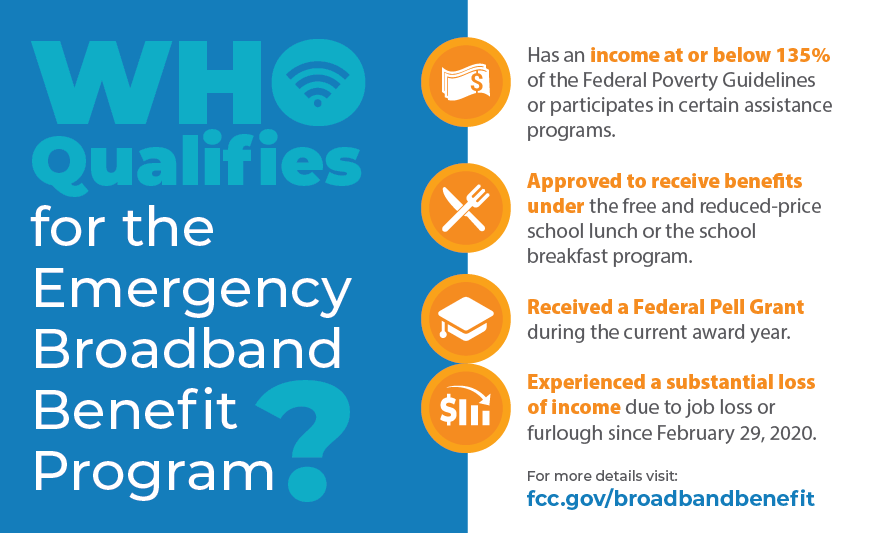What is the Emergency Broadband Benefit?
Updated January 2022: The EBB program is being phased out and replaced by the Affordable Connectivity Act, which will provide long-term relief for eligible households. To learn more and apply, visit our Affordable Connectivity Program page.
Summary: The Emergency Broadband Benefit (or EBB) Program is an effort by the FCC to keep households connected during the COVID-19 pandemic. Households that qualify can receive a discount of up to $50 on their internet plan. Keep reading to learn more about qualifications and what the program includes, or go to our application page to get started.
It’s no secret that the way we use the internet has changed since early 2020. Online learning, telehealth, and remote work have all rapidly expanded — and it’s a trend that’s not going away. A high-speed internet connection has been a lifeline for many of us, but it can also be another bill to worry about during tough financial times. In light of all of this, the FCC created a new program to help households stay connected.
What is the Emergency Broadband Benefit Program?
The Emergency Broadband Benefit (or EBB) program can save eligible households up to $50 each month on internet service. Eligible households on tribal lands are able to save up to $75 each month. The program brings affordable, high-speed internet to your home so you can stay connected to homework, job opportunities, healthcare, and more.
Since the end of 2019, the internet has become an even more essential part of our lives. For example, Zoom welcomed more new users in the first few months of 2020 than it did in all of 2019, and 36.2 million Americans are predicted to be working remotely by 2025. Whether you’re using video calls to catch up with friends or collaborate on work projects, it’s clear that high-speed internet access is a need.

That need also extends to students — even those who are back in the classroom. More than half of students say they use their home internet every day to do homework, and 70% of teachers assign homework that requires an internet connection to complete, according to the PEW Research Center.
So while there are certainly plenty of ways to fill empty time online, it can also be a lifeline to the rest of the world, and an important tool in completing work tasks and taking care of your health. The EBB program is an important step towards keeping households connected to the internet. But, it’s only available for a limited time, so if this is something that would help you or someone you know, be sure to get an application in as soon as possible.
There are some restrictions, though. There’s a limit of one discount per household — even if multiple members are eligible — and the discount is only applicable to certain parts of your internet plan (not taxes, for example).
Who Qualifies for the Emergency Broadband Benefit Program?
There are a few different ways to qualify for the EBB program. Of course, the first step is to find out if your internet service provider is participating — or switch to a participating EBB provider with service at your address.
Once you’ve found a provider, at least one member of your household needs to meet at least one of the following criteria:
- Has an income at or below 135% of the Federal Poverty Guidelines or participates in certain assistance programs such as SNAP, Medicaid, Lifeline, SSI, or Federal Public Housing Assistance
- Approved to receive benefits under the free and reduced-price school lunch or the school breakfast program
- Received a Federal Pell Grant during the current award year
- Experienced a substantial loss of income due to job loss or furlough since February 29, 2020, and the household had a total 2020 income at or below $99,000 for single filers and $198,000 for joint filers
Not sure if you qualify? The FCC’s Emergency Broadband Benefit page has more details.
How Do I Get Started with the Emergency Broadband Benefit?
Think you may qualify for the discount? There are just two steps to complete before you can get started with the program.
First, make sure you qualify by filling out the National Verifier eligibility form. Regardless of who your internet service provider is, you’ll need to complete this form and keep your Verifier ID number handy.
Next, contact a participating provider to select your plan and get started. This step will be a little bit different for every internet service provider. Generally speaking, if you’re starting a new plan, you’ll need to schedule an installation before you can enjoy the benefit. If you’re adding EBB to your current plan, it will likely be slightly a faster process.
In the market for a new internet service provider? EarthLink is a proud partner in this stimulus program. With EarthLink’s EBB program, you’ll have no activation fees, no credit checks, and no internet data caps — along with the discount.
You can find out more — and even sign up with your National Verifier ID — on our site, or you can call one of our Internet Experts at 8337872118 to get started.
